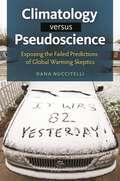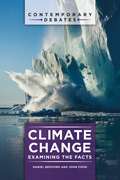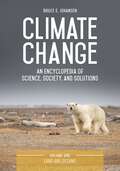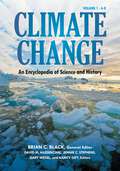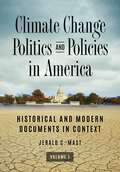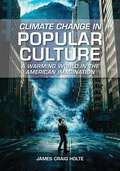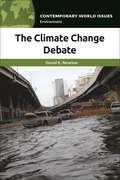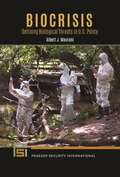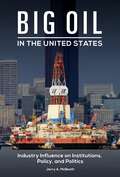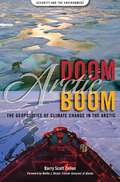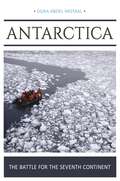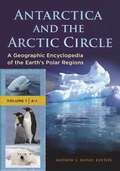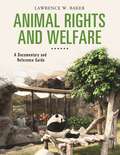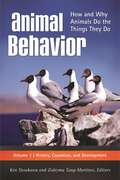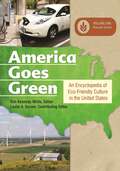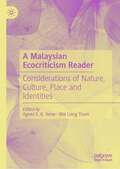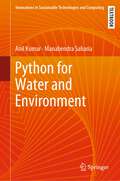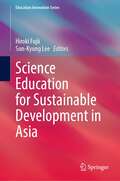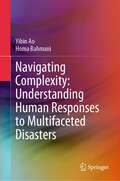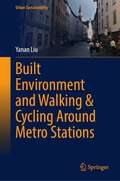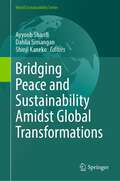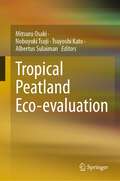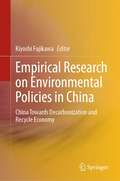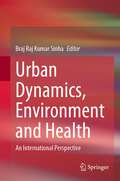- Table View
- List View
Encyclopedia of Cultivated Plants [3 volumes]: From Acacia to Zinnia [3 volumes]
by Christopher CumoReaders of this expansive, three-volume encyclopedia will gain scientific, sociological, and demographic insight into the complex relationship between plants and humans across history.Comprising three volumes and approximately half a million words, this work is likely the most comprehensive reference of its kind, providing detailed information not only about specific plants and food crops such as barley, corn, potato, rice, and wheat, but also interdisciplinary content that draws on the natural sciences, social sciences, and humanities. The entries underscore the fascination that humans have long held for plants, identifies the myriad reasons why much of life on earth would be impossible without plants, and points out the intertwined relationship of plants and humans—and how delicate this balance can be. While the majority of the content is dedicated to the food plants that are essential to human existence, material on ornamentals, fiber crops, pharmacological plants, and carnivorous plants is also included.
Climatology versus Pseudoscience: Exposing the Failed Predictions of Global Warming Skeptics
by Dana NuccitelliThis book explains the science of climate change in plain language and shows that the 2 to 4 percent of climate scientists who are skeptical that humans are the main cause of global warming are a fringe minority—and have a well-established history of being wrong.Although some politicians, pundits, and members of the public do not believe it, global warming predictions by mainstream climate scientists have been remarkably accurate while those made by climate deniers have not. And if mainstream global warming predictions continue to prove correct, the window of opportunity to prevent a climate catastrophe is quickly closing. This book is the first to illustrate the accuracy—and inaccuracy—of global warming predictions made by mainstream climate scientists and by climate contrarians from the 1970s to the present day. Written in simple, non-technical language that provides an accessible explanation of key climate science concepts, the book will appeal to general audiences without previous knowledge about climate science.Author Dana Nuccitelli, an environmental scientist and risk assessor, discusses some key climate discoveries dating back to the 19th century and debunks myths such as the idea that climate scientists and climate models have grossly over-predicted global warming. He addresses recent findings of a 97-percent consensus in the peer-reviewed scientific literature that humans are causing global warming—a nearly unanimous agreement that formed in the early 1990s and has grown through the present day. Nuccitelli also discusses what the future climate might look like if current trends continue unabated, and what we as a global society need to do to prevent a climate catastrophe.
Climate Change: Examining the Facts (Contemporary Debates)
by Daniel Bedford John CookClimate change is one of the most controversial and misunderstood issues of the 21st century. This book provides a clear understanding of the issue by presenting scientific facts to refute falsehoods and misinformation—and to confirm the validity of other assertions.Is public understanding of global warming suffering from politically biased news coverage? Is it true that the global scientific community has not reached a consensus on whether humans are causing climate change? This important book addresses these questions and many more about global warming, identifying common claims about climate change and using quantifiable, evidence-based information to examine their veracity.The authors of this work examine 35 specific claims that have been made about global climate change by believers and skeptics. These assertions—some true, some false—will guide readers to a much deeper understanding of the extent of climate change; whether any climate change that is taking place is human-caused; whether climate change is likely to be a serious problem in the future; whether scientists agree on the fundamentals of climate change; and whether climate change impacts can be mitigated. Examples of specific issues that are scrutinized and explained in the book include: trends in the extent and condition of Arctic and Antarctic Sea ice packs, the accuracy of climate forecasting models, whether extreme weather events are increasing as a result of climate change, and the benefits and drawbacks of various schemes to limit greenhouse gas emissions.
Climate Change [3 volumes]: An Encyclopedia of Science, Society, and Solutions [3 volumes]
by Bruce E. JohansenThis three-volume set presents entries and primary sources that will impress on readers that what we do—or don't do—today regarding climate change will dramatically influence what life on this planet will be like for untold numbers of generations.How are the behaviors of birds, butterflies, and other migratory animals connected to climate change? What does the term "thermal inertia" mean, and what does this geophysical effect have on predicting what the planet's future will be like? What is the context for the effects we are seeing on various forms of animal life, from migrating birds to polar bears to mosquitoes that transmit Zika and other diseases?Climate Change: An Encyclopedia of Science, Society, and Solutions combines entries describing Earth's variable climatic history, references to scientific literature, weather record data, and selected primary documents to present readers with a comprehensive account of global warming's effects worldwide. By examining verifiable, quantitative information such as the frequency and intensity of hurricanes and changes in the hydrological cycle, as well as clear patterns and trends of alternating droughts and deluges and wildfires, melting ice, and rising seas, readers will be able to understand why scientists are so concerned about the future of our climate. Researchers will benefit from detailed explanations of scientific topics such as thermal inertia, feedbacks, and tipping points; and receive invaluable context on the role of energy use in climate change, including automobiles and air travel. Readers will learn about the role of China in the current global climate and in the future; the widespread effects of climate change on agriculture; and how indigenous peoples' lives are being impacted, from drought and the Navajos to hunters' lives in the Arctic. The work concludes with thought-provoking debates regarding potential solutions, from wind power and solar power to geo-engineering.
Climate Change [4 volumes]: An Encyclopedia of Science and History [4 volumes]
by Brian C. Black, David M. Hassenzahl, Jennie C. Stephens, Gary Weisel, and Nancy GiftThis book provides a holistic consideration of climate change that goes beyond pure science, fleshing out the discussion by considering cultural, historical, and policy-driven aspects of this important issue.Climate change is a controversial topic that promises to reframe rudimentary ideas about our world and how we will live in it. The articles in Climate Change: An Encyclopedia of Science and History are designed to inform readers' decision making through the insight of scholars from around the world, each of whom brings a unique approach to this topic. The work goes beyond pure science to consider other important factors, weighing the cultural, historical, and policy-driven contributors to this issue. In addition, the book explores the ideas that have converged and evolved in order to clarify our current predicament. By considering climate change in this holistic fashion, this reference collection will prepare readers to consider the issue from every angle. Each article in the work is suitable for general readers, particularly students in high school and college, and is intended to inform and educate anyone about climate change, providing valuable information regarding the stages of mitigation and adaptation that are occurring all around us.
Climate Change Politics and Policies in America [2 volumes]: Historical and Modern Documents in Context [2 volumes]
by Jerald C. MastThis collection of primary sources, illuminated by extensive contextual analysis, provides a comprehensive and balanced survey of the evolution of global climate change policies and politics in the United States.This extensive collection of primary documents examines the history of climate science; various policy prescriptions for addressing the effects of climate change; political fault lines with respect to international efforts to address global warming; claims regarding the influence of industry groups and environmental "radicals" on climate policy and science; and the impact of climate change on other policy areas such as public health, energy, economic development, and wilderness conservation. The set includes excerpts from important scientific papers and government reports, political speeches from presidents and other influential lawmakers, perspectives from environmental activists and conservative think-tanks, editorial essays from leading media figures, provisions of major laws, and more. Together, these documents provide a broad range of perspectives, from scientific fields as well as from political and ideological standpoints that have emerged in response to the debate surrounding climate change. They offer readers a greater understanding of the arguments not only of lawmakers, activists, and scientists leading efforts to fight, mitigate, and adapt to climate change but also of those skeptical of climate change.
Climate Change in Popular Culture: A Warming World in the American Imagination
by James Craig HolteAn invaluable resource for general readers investigating climate change, this book examines the impact of climate change on popular culture and analyzes how writers and directors treat the disasters caused by climate change in their novels and films.Climate Change in Popular Culture: A Warming World in the American Imagination is the first study that includes analyses of both fiction and popular nonfiction works devoted to climate change. In addition, the book examines a number of classic works from the perspective of the growing field of climate change literature and includes a brief history of climate change science as well basic scientific definitions, all intended for general readers.The text provides an introduction to the science, politics, and economics of climate change. It also includes both historical overviews and potential probable futures projected by leading climate scientists and environmental writers. In addition, the text looks at how such creative writers and directors as Margaret Atwood, John Steinbeck, Paulo Bacigalupi, Kim Stanley Robinson, T. C. Boyle, Michael Crichton, and Octavia Butler, among others, have used the disasters caused by climate change in their work.
The Climate Change Debate: A Reference Handbook (Contemporary World Issues)
by David E. NewtonThe Climate Change Debate: A Reference Handbook provides an in-depth look at climate change facts and statistics. It also discusses debate surrounding the scientific consensus.The Climate Change Debate: A Reference Handbook covers the topic of climate change from the earliest days of planet Earth to the present day. Chapters One and Two provide a historical background of climate change and a review of current problems, controversies, and solutions. The remainder of the book consists of chapters that aid readers in continuing their own research on the topic, such as an extended annotated bibliography, chronology, glossary, noteworthy individuals and organizations in the field, and important data and documents.The variety of resources provided, such as further reading, perspective essays about climate change, a historical timeline, and useful terms in the climate change discourse, differentiates this book from others in the field. The book is intended for readers of high school through the community college level, along with adult readers who may be interested in the topic.
Biocrisis: Defining Biological Threats in U.S. Policy (Praeger Security International)
by Albert J. MauroniThis book examines the recent intersection of national security and public health regarding biological threats to the U.S. populace and proposes improvements to the executive and legislative development of U.S. policy addressing biological threat mitigation.Over the last 20 years, the national security community has engaged with disease-related issues that have traditionally been the scope of public health agencies. The federal government's response has been to create a single national biodefense strategy, which has been largely ineffective in improving conditions due to poor terminology, a lack of leadership, and a failure to assess government programs.Applying a public policy framework, Albert J. Mauroni examines how the government addresses biological threats-including disease prevention, bioterrorism response, military biodefense, biosurety, and agricultural biosecurity and food safety. He proposes a new approach to countering biological threats, arguing that lead agencies should focus on implementing discrete portfolios with annual assessments against clear and achievable objectives.
Big Oil in the United States: Industry Influence on Institutions, Policy, and Politics
by Jerry A. McBeathThis book explains how and why large oil-producing corporations have affected government institutions, energy policy, and politics in the United States—and suggests how their influence can be reduced.Big oil is the leading factor in U.S. energy politics today; the largest oil-producing companies also constitute a formidable force and interest group in American politics. This book examines why oil is so important and how the prominence of huge corporations—often working in the absence of countervailing forces—has affected government institutions, policy (with a focus on energy policy), and politics in the United States.Analyzing big oil's influence on political outcomes, particularly through campaign contributions and lobbying, this book shows how strong corporate power affects political participation. The book documents how the influence of big oil flows in all directions, intricately connecting U.S. policies at all levels—foreign policy, federal, state, and even local—regarding oil exploration, development, production, and transportation. Readers will come away with a clear understanding of how these multi-tiered relationships between oil corporations and governments work to the advantage of corporations—and to the disadvantage of states and the citizens they represent.
Arctic Doom, Arctic Boom: The Geopolitics of Climate Change in the Arctic (Security and the Environment)
by Dr. Barry Scott ZellenAn expert examination of the way climate change is transforming the Arctic environmentally, economically, and geopolitically, and how the challenges of that transformation should be met.A growing number of scientists estimate that there will be no summer ice in the Arctic by as soon as 2013. Are we approaching the "End of the Arctic?" as journalist Ed Struzik asked in 1992, or fully entering the "Age of the Arctic," as Arctic expert Oran Young predicted in 1986? Arctic Doom, Arctic Boom: The Geopolitics of Climate Change in the Arctic looks at the uncertainty at the top of the world as the shrinking of the polar ice cap opens up new sea lanes and the vast hydrocarbon riches of the Arctic seafloor to commercial development and creates environmental disasters for Arctic biota and indigenous peoples. Arctic Doom, Arctic Boom explores the geopolitics of the Arctic from a historical as well as a contemporary perspective, showing how the warming of the Earth is transforming our very conception of the Arctic. In addition to addressing economic and environmental issues, the book also considers the vital strategic role of the region in our nation's defenses.
Antarctica: The Battle for the Seventh Continent
by Doaa Abdel-MotaalThe thawing Antarctic continent offers living space and marine and mineral resources that were previously inaccessible. This book discusses how revisiting the Antarctic Treaty System and dividing up the continent preemptively could spare the world serious conflict.The Antarctic Treaty and related agreements—collectively known as the Antarctic Treaty System (ATS)—regulate the seventh continent, which is the only continent without a native human population. The main treaty within the ATS came into force in 1961 and suspended all territorial claims in Antarctica. The Antarctic Environmental Protocol followed in 1998 and prohibited any minerals exploitation in the continent. With this prohibition up for review in 2048, this book asks whether the Antarctic Treaty can continue to protect Antarctica. Doaa Abdel-Motaal—an expert on environmental issues who has traveled through the Arctic and Antarctic—explains that the international community must urgently turn its attention to examining how to divide up the thawing continent in a peaceful manner. She discusses why the Antarctic Treaty is unlikely to be an adequate measure in the face of international competition for invaluable resources in the 21st century. She argues that factors such as global warming, the growth in climate refugees that the world is about to witness, and the increasingly critical quest for energy resources will make the Antarctic continent a highly sought-after objective.Readers will come to appreciate that what has likely protected Antarctica so far was not the Antarctic Treaty but the continent's harsh climate and isolation. With Antarctica potentially becoming habitable only a few decades from now, revisiting the Antarctic Treaty in favor of an orderly division of the continent is likely to be the best plan for avoiding costly conflict.
Antarctica and the Arctic Circle [2 volumes]: A Geographic Encyclopedia of the Earth's Polar Regions [2 volumes]
by Andrew J. HundThis one-stop reference is a perfect resource for anyone interested in the North and South Poles, whether their interest relates to history, wildlife, or the geography of these regions in the news today.Global warming, a hot topic among scholars of geography and science, has led to increased interest in studying the earth's polar ice caps, which seem to be melting at an alarming rate. This accessible, two-volume encyclopedia lays a foundation for understanding global warming and other issues related to the North and South Poles. Approximately 350 alphabetically arranged, user-friendly entries treat key terms and topics, important expeditions, major figures, territorial disputes, and much more.Readers will find information on the explorations of Cook, Scott, Amundsen, and Peary; articles on humpback whales, penguins, and polar bears; and explanations of natural phenomena like the Aurora Australis and the polar night. Expedition tourism is covered, as is climate change. Ideal for high school and undergraduate students studying geography, social studies, history, and earth science, the encyclopedia will provide a better understanding of these remote and unfamiliar lands and their place in today's world.
Animal Rights and Welfare: A Documentary and Reference Guide (Documentary and Reference Guides)
by Lawrence W. BakerThrough the use of primary source documents, readers can learn about key opinions and legislation in the important field of animal rights and welfare—a current and highly relevant topic.Animal Rights and Welfare: A Documentary and Reference Guide addresses a broad range of key topics within the subject of animal rights and welfare, including zoos, animal testing, philosophy regarding the treatment of animals, and practical measures instituted to protect animals, supplying readers with an impartial and authoritative resource for understanding the history of animal rights and the issues that dominate discussions about animal rights. Organized chronologically, the book discusses topics such as animal rights within the context of hunting for food, pelts, and other body parts, as well as for recreation; working animals; animals used for education or scientific and medical research; animals in the fashion and entertainment industries; and the food industry.The text provides reproductions of dozens of carefully selected primary documents from the time of Aristotle (B.C.) to present day to engage readers and provide opportunities for them to apply their critical thinking and analysis skills. The text of each document is introduced by a headnote to place it in context and concludes with analysis that details its significance and clarifies specific passages when needed. Each document or excerpt is followed by a full citation of the document.
Animal Behavior [3 volumes]: How and Why Animals Do the Things They Do [3 volumes]
by Alison M. Bell Andrew P. King Anna Dornhaus Anne Danielson-François Anthony C. Little Benedict C. Jones Bennett G. Galef Brett M. Gibson Brian Keane Bronwyn H. Bleakley Çağlar Akçay Carolynn L. Smith Catherine A. Marler Charles T. Snowdon Christopher D. Watkins Christopher Harshaw Christopher S. Evans David B. Mcdonald David Clark David Crews David F. Sherry David J. White Douglas W. Mock Geoffrey E. Hill George Uetz Guillermo Paz-Y-Miño-c James L. Gould Janis L. Dickinson Jason Low Jeffrey R. Alberts Ken Yasukawa Kenyon B. Mobley Laura Smale Lee Alan Dugatkin Lee C. Drickamer Lisa M. Debruine Mark E. Hauber Matthew J. Fuxjager Megan Hastings Hagenauer Meredith J. West Michael D. Beecher Michael J. Ryan Michelle Pellissier Scott Nancy G. Solomon Rachel A. Page Renée A. Duckworth S. Craig Roberts Sarah Jane Alger Sean P. Bradley Terry J. Ord Theodore Stankowich Walter D. Koenig Ximena E. Bernal Zenobia Lewis Zuleyma Tang-MartínezDiscover why animals do what they do, based on their genes, physiologies, cultures, traditions, survival and mating advantages, and evolutionary histories—and find out how studying behavior in the animal world helps us understand human behavior.The three volumes of Animal Behavior: How and Why Animals Do the Things They Do cover the breadth of the field, addressing causation, development, function, and evolution in a wide range of animals, from invertebrates to humans. Inspired by Nobel laureate Nikolaas Tinbergen's work, the first two volumes follow Tinbergen's four classic questions of animal behavior, while the third volume supplies integrated examples of Tinbergen's investigative process applied in specific cases.Written in an engaging, accessible manner ideal for college students as well as general audiences, this evidence-based collection provides a fascinating tour of animal behaviorists' findings, such as how animal communication can be truthful or deceitful, the deadly serious business behind clashes in the "battle of the sexes," and how documentation of animal behavior can lead to a deeper understanding of human behavior. Each chapter provides both historical background and information about current developments in animal behavior knowledge.
America Goes Green [3 volumes]: An Encyclopedia of Eco-Friendly Culture in the United States [3 volumes]
by Leslie A. DuramThis three-volume encyclopedia explores the evolution of green ideology and eco-friendly practices in contemporary American culture, ranging from the creation of regional and national guidelines for green living to the publication of an increasing number of environmental blogs written from the layperson's perspective.Evidence of humanity's detrimental impact on the environment is mounting. As Americans, we are confronted daily with news stories, blogs, and social media commentary about the necessity of practicing green behaviors to offset environmental damage. This essential reference is a fascinating review of the issues surrounding green living, including the impact of this lifestyle on Americans' time and money, the information needed to adhere to green principles in the 21st century, and case studies and examples of successful implementation.America Goes Green: An Encyclopedia of Eco-Friendly Culture in the United States examines this gripping topic through 3 volumes organized by A–Z entries across 11 themes; state-by-state essays grouped by region; and references including primary source documents, bibliography, glossary, and green resources. This timely encyclopedia explores the development of an eco-friendly culture in America, and entries present the debates, viewpoints, and challenges of green living.
A Malaysian Ecocriticism Reader: Considerations of Nature, Culture, Place and Identities
by Agnes S. K. Yeow Wai Liang ThamThis collection of essays brings together ecocritical interpretations of Malaysian texts – including fiction, nonfiction, and other media / cultural expressions. It includes original works by environmental activists as well as emerging and established scholars, who collectively analyse various aspects of Malaysian ecological discourse.The contributors address crucial – and often controversial – topics such as local ecological imaginations, wildlife conservation, overdevelopment, postcolonial ecological identities, biopolitics, nature and sexuality, nature and race, the commodification of nature, nature–culture embodiments and entanglements, human–animal relations, waste and materiality, human and other-than-human agency, toxicity and slow violence, self-representations as well as attitudes towards land, nativity and indigeneity, migrancy and diaspora.Readers will gain valuable insights into the ways in which environments and ecological relationships are mediated within this national space, while opening up room to theorise beyond its boundaries.
Python for Water and Environment (Innovations in Sustainable Technologies and Computing)
by Anil Kumar Manabendra SahariaThis textbook delves into the practical applications of surface and groundwater hydrology, as well as the environment. The Part I, "Practical Python for a Water and Environment Professional," guides readers through setting up a scientific computing environment and conducting exploratory data analysis and visualization using reproducible workflows. The Part II, "Statistical Modeling in Hydrology," covers regression models, time series analysis, and common hypothesis testing. The Part III, "Surface and Subsurface Water," illustrates the use of Python in understanding key concepts related to seepage, groundwater, and surface water flows. Lastly, the Part IV, "Environmental Applications," demonstrates the application of Python in the study of various contaminant transport phenomena.
Science Education for Sustainable Development in Asia (Education Innovation Series)
by Hiroki Fujii Sun-Kyung LeeThis book presents an Asian perspective on transformative science education in the context of the United Nations' Sustainable Development Goals (SDGs). The chapters are written by contributors who practiced science education for sustainability in a research project entitled “Teacher Education for ESD in the Asia-Pacific Region” from 2017 to 2019, supported by the Japan Society for the Promotion of Science, and the Japanese National Commission for UNESCO. The book showcases the contributors’ innovations in science education for sustainability, presenting case studies of science teaching and learning, science curriculum and assessment, science education in collaboration with local communities, and science teacher education. Embodying Asian sustainability education paradigms, policies, and practices, these case studies depict the diversity and uniqueness of natural, social, and cultural contexts in Asia, while demonstrating their commonalities. Through examining these case studies, this book aims to provide examples for praxis, and prospects, for new science classes, curricula, and teacher education in implementing education for sustainable development.
Navigating Complexity: Understanding Human Responses to Multifaceted Disasters
by Yibin Ao Homa BahmaniThis thought-provoking book unravels the intricate interplay between human behavior and disasters, weaving a rich narrative that transcends traditional boundaries. Embark on a captivating exploration of human responses to multifaceted disasters with this book. Unveiling the human psyche and the intricate web of emotions that intertwine with disaster events, this book offers a profound understanding of human responses to multifaceted disasters.Written with precision and meticulous research, this book captivates scholars, practitioners, and policymakers alike. Its multidimensional perspectives offer valuable insights for disaster management, urban planning, sociology, and public health, transcending disciplinary boundaries.
Built Environment and Walking & Cycling Around Metro Stations (Urban Sustainability)
by Yanan LiuThis book explores the relationship between pedestrians/cyclists’ mode and route choice to/from metro/railway stations and the micro-level (street-scale) built environment in a second-tier city in China. More specifically, it investigates how the street-scale built environment influences pedestrians/cyclists’ mode choice and route choice behavior and examines user preferences for the micro-level built environment around metro stations. The focus on a second-tier city is motivated primarily to expand the set of Chinese cities where the effects of the built environment on pedestrian/cyclist mode and route choice have been studied. Results demonstrate the effects of the street-scale built environment on pedestrian flows. The effects are higher for the main road, which is directly connected with the metro station. The findings of this book are expected to support the design of preferred walking/biking built environments around a metro station. This book appeals to urbanists, planners, engineers, policy makers, and those interested in a wide-ranging overview of slow/green transportation and built environment promotion. These methods not only help to understand the quantitative relationship between built environment design and travel behavior but also support the evaluation and assessment of built environment design in urban planning projects. It reduces the gap in our understanding of the quantitative relationship between the micro-level built environment and pedestrians/cyclists’ transportation mode and route choice around the metro station. Both stated choice data and revealed choice data were used. An extended set of micro-level built environment attributes was developed. Besides the widely studied transportation-related factors, street-level built environment factors were studied using quantitative methods.
Bridging Peace and Sustainability Amidst Global Transformations (World Sustainability Series)
by Ayyoob Sharifi Dahlia Simangan Shinji KanekoThis book is the sequel to a well-received book titled ‘Integrated Approaches to Peace and Sustainability’ that aims to further advance the understanding of the dynamic interactions between various components of peace and sustainability. How are peace and sustainability linked to each other, and what are the key parameters that define the nexus between them? This book addresses those questions through a combination of theoretical studies and empirical research that contextualize peace and sustainability issues amid global transformations. The conceptual and empirical linkages between peace and sustainability are widely recognized in academic and policy circles. The adoption of the 2030 Agenda for Sustainable Development confirms this recognition. However, many of the initiatives on peace and sustainability operate in silos, undermining the positive and mutually reinforcing relationship between them. Enhanced integration of peace and sustainability components is imperative for addressing complex challenges that come with global transformations that are manifested environmentally, socially, politically, and economically across levels. It is, therefore, crucial to identify the pathways that enhance the peace-promoting potential of sustainability and the sustainability-promoting potential of peace. The contributions in this edited book elaborate on such pathways by offering insights related to different social, economic, and environmental aspects of the peace-sustainability nexus. Given its inter- and trans-disciplinary focus, the book is of interest to policymakers and researchers working in different areas of peace and sustainability. It contributes to ongoing academic and policy discussions surrounding the outcomes of and challenges to achieving the Sustainable Development Goals (SDGs), particularly SDG 16 on peace, justice and strong institutions.
Tropical Peatland Eco-evaluation
by Mitsuru Osaki Nobuyuki Tsuji Tsuyoshi Kato Albertus SulaimanThis book focuses on eco-evaluation system monitoring and sensing, carbon-water modeling, mapping, and disaster prediction. It is the 3rd book on tropical peatland issues, following 1st "Tropical Peatland Ecosystem" and 2nd "Tropical Peatland Eco-management" publications. Tropical peatland is also a wetland, mangrove, and rainforest. With this nature, two major key elements of tropical peatland are water and forest. This book introduces the relationship and interaction among water, oxygen, and nutrients as well as aspects of the forest as the driving force of carbon stock and the carbon cycle. Eco-evaluation system is key to conserving, managing, and restoring tropical peatlands, however comprehensive system for Eco-evaluation in the Tropics is not yet established. This book reviews and proposes Eco-evaluation methods in the Tropics Ecosystem, focusing mainly on the peatland ecosystem and others, covering Social Capital such as Credit, Bonds, National Accounting, etc.
Empirical Research on Environmental Policies in China: China Towards Decarbonization and Recycle Economy
by Kiyoshi FujikawaThis book presents an empirical study of the effects of environmental policies on China and its neighboring countries, with a focus on waste and climate policies in China. The two major carbon policies have to do with carbon markets and renewable energy. The authors first examine the effectiveness of the Asian carbon market. Because of the consumption of goods beyond provincial borders, nationwide carbon markets are rather difficult to operate; therefore, a desirable initial allocation in the carbon market is proposed in this book. As for renewable power, its sources have not been fully utilized owing to a regional mismatch of supply and demand, so optimal locations of renewable energy are shown. The book also contains an analysis of the environmental and economic impacts of changes in resource circulation in East Asia. Although motorization is advancing rapidly, the vein industry for recycling used cars has not progressed. The authors estimate the amount of materials from used cars including new energy vehicles (electric and fuel cell vehicles) and propose desirable policies for used vehicles. East Asia is interdependent with respect to carbon and waste as well as the economy. China has regulated the import of waste recently and has started recycling its own wastes, putting pressure on neigboring countries to recycle their waste domestically. The authors estimate the environmental and economic impacts of such policy changes.
Urban Dynamics, Environment and Health: An International Perspective
by Braj Raj Kumar SinhaThe comprehensive volume focuses on spatial, temporal, conceptual and empirical approaches to various elements of urban dynamics, environment and urban health. It demonstrates a multidisciplinary account of the significant dimensions of urbanization and urban life. Chapters by leading international experts are presented in sections on urban dynamics, Urban Environmental Issues, Urban Health Problems and Urban Development, Planning and Policies. Each chapter provides a breadth of information on conceptual and empirical studies of urban issues. It enables the readers to understand the interconnections of various vital elements of each urban-related topical issue locally, regionally and globally. Extensive maps, charts, diagrams and tables as cartographic tools facilitate the reader’s understanding. It also outlines an action plan for policy program change in both the developed and less developed countries toward sustainable urban development and environment for better health, prosperity and quality of life of the present and future urban population. It is an indispensable reference for students, research scholars of geography and environmental, medical, and social sciences at undergraduate and postgraduate levels.

